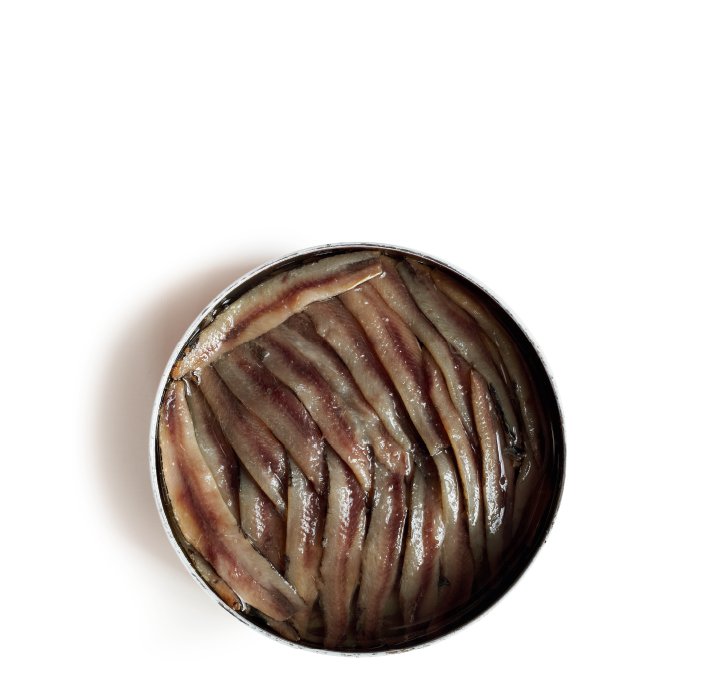Good Cook (2 page)
Authors: Simon Hopkinson

serves 4–6, as nibbles
3 tbsp butter
2 large onions, halved, then thinly sliced
7 oz port or Marsala
1 tsp redcurrant jelly
3 tbsp red wine vinegar
salt
7 oz (approx.) all-butter puff pastry
20–25 anchovy fillets, cut in half lengthways
herbes de Provence
cayenne pepper
These incredibly delicious little munchies are inspired by a little taster the chef Pierre Koffmann used to serve at his original, very small and railway carriage–thin Tante Claire restaurant in Chelsea, London. I recall eating these as long ago as 1980 and thinking, then, that they were one of the most delicious things I had ever put in my mouth. The following recipe is my interpretation of that original, thirty-year-old memory.
If you are an avid pasta maker, you may well own a pasta-rolling machine. If so, then this apparatus is ideal for rolling the pastry as thin as possible. If not, however, just do the very best you can with a rolling pin. If using the pasta machine, take the pastry up to notch number 5.
Melt the butter in a heavy-based pot and add the onions. Slowly cook them, stirring regularly, until well softened and just beginning to color—about 25–30 minutes. Add the port/Marsala, jelly, vinegar and very little salt. Bring up to a simmer, then reduce until all the liquid has completely evaporated; a heat diffuser pad placed underneath towards the end of the reduction will help prevent any scorching. Scrape into a bowl and cool completely.
Preheat the oven to 200°C/400°F/gas mark 6.
Cut the pastry into 4 equal pieces. Roll each one out into a rectangle about 10 in long by 4 in wide—and as thinly as possible. Lightly grease a large, flat baking tray, lay the pastry sheets on it and prick them all over with a fork. Put the whole tray
into the freezer until the pastry is stiff and firm. (If you have a second flat baking tray, place this in the oven now to heat up; this will help the underneath of the pastry to become good and crisp while baking.)
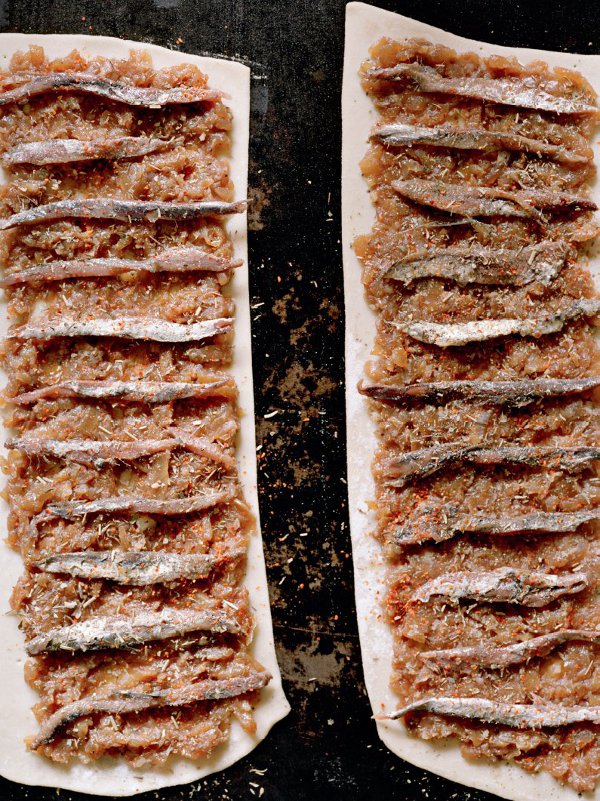
Remove the baking tray from the freezer and, using a palette knife, quickly spread each sheet of pastry with a thin layer of the onion mixture, leaving a small gap around the edge. Following the length of the pastry rectangle, lay a half anchovy fillet at approximately ½ inch intervals. Lightly sprinkle with the herbs and cayenne pepper. Bake in the oven (on the preheated baking tray) for 8–10 minutes, then loosely cover with a piece of kitchen foil and continue baking for a further 5 minutes or so; this is to prevent the anchovies scorching. Carefully lift the pastries from the tray and lay on a cooling rack until warm.
To serve, place the pastries on a chopping surface and, with a sharp, heavy-bladed knife, deftly slice equally between the anchovies to form little pastry fingers. Serve without delay, and with drinks. Excellent with ice-cold Martinis.
serves 4
for the croquettes
27 oz spinach
44 oz ricotta
3 egg yolks, beaten
3 oz grated Parmesan
freshly grated nutmeg, to taste
salt and freshly ground black pepper
oil, for frying plain flour
1 egg, beaten
1
/
3
–½ cup fine breadcrumbs
for the anchovy sauce (makes approx. 9 oz)
7
/
8
cup unsalted butter
3 egg yolks
1 tbsp water
2 oz tin of anchovy fillets, drained of oil
lemon juice to taste
a few shakes of Tabasco sauce
These soft and creamy morsels are loosely based upon an Italian gnocchi recipe, but with an added coating to give an interesting, contrasting crunch. I know that it is a curiously off-putting comparison, but the result of this bread-crumbed coating is as important to this dish as is the crisp coating one finds on a proper chocolate truffle that has been hand-dipped into melted chocolate, so that it has that deliciously crisp bite to it beneath the final cocoa dusting. Chocolate truffles that have only been rolled in cocoa are not, as far as I am concerned, chocolate truffles at all. Incidentally, do try not to think of chocolate when you are tasting spinach and anchovy…
Blanch the spinach briefly in boiling water. Drain, then refresh in ice-cold water. Squeeze in a tea towel until dry. Using a food processor, purée together the spinach, ricotta, egg yolks, Parmesan, nutmeg, a little salt and plenty of pepper until well blended, but not too smooth. Spread on a shallow tray, press plastic wrap over the surface and allow to firm up in the fridge for a minimum of 2 hours.
To make the sauce, melt the butter and pour it into a heated jug (fill with boiled
water, then discard), then keep moderately hot. Place the yolks in a small food processor or similar, add the water and process until pale and creamy. With the motor running, pour in the melted butter in a thin stream, but leaving most of the milky residue behind in the jug, until glossy and thick. Add the drained anchovies, a touch of lemon juice and further process until smooth and tasty. Now spike with Tabasco to taste. Keep the sauce warm while the croquettes are cooking. (Note: if you feel that the sauce is really too thick, then a little of that milky residue may be added as a final loosener.)
Heat the oil for frying in either a solid, deep pan or, for the absolute ease of it, an electric deep-fryer. Either way, aim for about 325–340ºF, or when a small piece of bread turns pale golden in about a minute. Form the spinach mixture into oval shapes with the help of two tea spoons. Briefly roll in the flour, then in the beaten egg and finally coat in breadcrumbs. Work quickly, as the mixture can quickly soften. You should finish with 3 or 4 croquettes per person, depending upon spoon size.
Deep-fry the croquettes for 4–5 minutes (in batches, so as not to overcrowd the deep-fryer or pan), drain on paper towels and keep warm in a low oven. Serve forthwith, accompanied by the anchovy sauce.
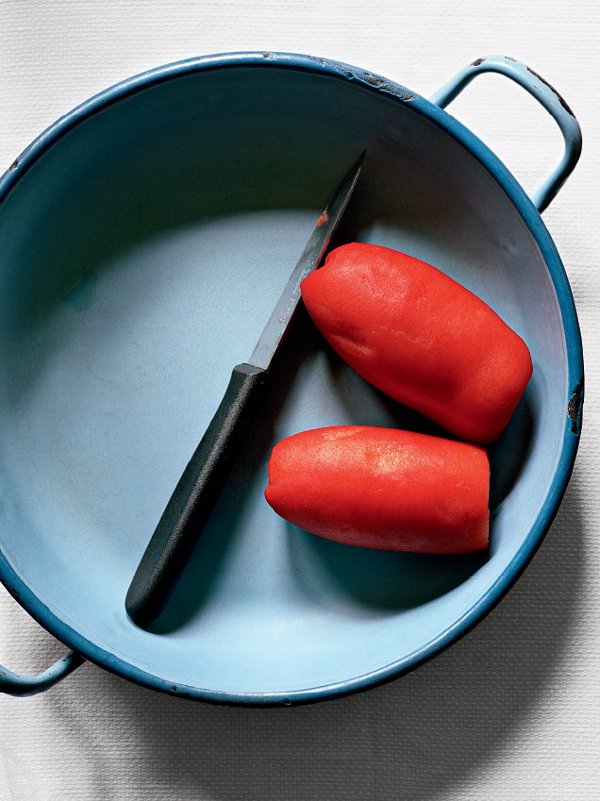
serves any number…
When I first wrote a recipe for this much-debated salad (about seventeen years ago), I was not a great fan of tinned tuna; I could only see it as a kind of upmarket catfood. But, truly, good processed tuna was hard to find anywhere in those days, unless you had access to big-city Italian or Spanish delis, say. So, it was not until I discovered the delights of the Spanish brand Ortíz, and their
bonito ventresca
(tuna belly) packed in olive oil, that I was finally enlightened to how delicious such tinned fish can be. Their anchovy fillets, too, are among the very best I have tasted.
That which I insisted upon for my salad, then, was for the tuna to be ditched in favor of an increase in anchovies; which, in fact, I could still stand by, so much do I love them. However, this belly stuff is quite marvelous, separating into soft, fatty pieces when nudged by the thumb, falling over the surface of the salad in pale pink flakes.
For once, I have decided not to give this recipe in a conventional manner. It is entirely up to you how much, or how little of each ingredient you wish to use. However, apart from
the fishes
, you should not omit the following four items:
tomatoes
,
boiled eggs
,
black olives
and
olive oil
—preferably French, niçoise even better (the most admired local brand, Alziari, in its colorful tin, is very good, if pricey). Also, try to obtain tiny little niçoise olives. The tomatoes, naturally, should be ripe, deeply flavored and heavy with juice. If you have chosen plum tomatoes, core and quarter them, and, if they are large, cut them possibly into sixths, or even eighths.
Choose good, large eggs that you know will have a deep orange yolk—simply because they will look fab in the salad—but that are not absolutely fresh (difficult to peel). Place them in a pan of cold water, bring up to a definite boil and then switch off the heat. Cover, leave for 5 minutes, then cool under a cold running tap for 2–3 minutes. This method will give a white that isn’t rubbery, together with a yolk that is soft in the center. Best quartered.
Other garnishes to add to the tuna and/or anchovies, together with the essential tomatoes, eggs, olives and their oil, can vary widely—and by whim, to a certain extent. Personally, I favor peeled and sliced
cucumber
; thinly sliced bulbous
spring onions
; large, old-fashioned blowsy
capers
rather than tiny tots, but never those dreadful caper berries; very thin
haricots verts
, topped and tailed, quickly boiled until tender, not crunchy. Small, super-fresh, tender
broad beans
and
artichokes
, both raw, trimmed and sliced, may further be included during their brief season. I used to add sliced new potatoes too, but went off the idea some years ago, now.
If you insist upon a few salad leaves (I remain ambivalent here) simply because it is called a “salad,” just use the very inner leaves of a
soft round lettuce
, nothing more, as a rumpled bed upon which to rest the other salad components. And if you want herbs somewhere, add
basil
and maybe some
feathery chervil
to sprinkle over the finished dish as little sprigs. It adds a pleasing, faintly aniseed note, so particular to the Côte d’Azur. Finally, I need the
merest whiff of garlic
somewhere, though some might vehemently disagree, and do. A clove or two crushed and infused in the olive oil, then discarded, is a delicate notion.
To serve the salade niçoise, nicely arrange the ingredients in a shallow, white dish in a way that pleases you most. Liberally dress with olive oil (garlic-infused, or not) and the merest trickle of
red wine vinegar
, then season with care. And, by the way, to use a slice of rare-grilled fresh tuna in this salad is a notion only to be entertained by the permanently bewildered.
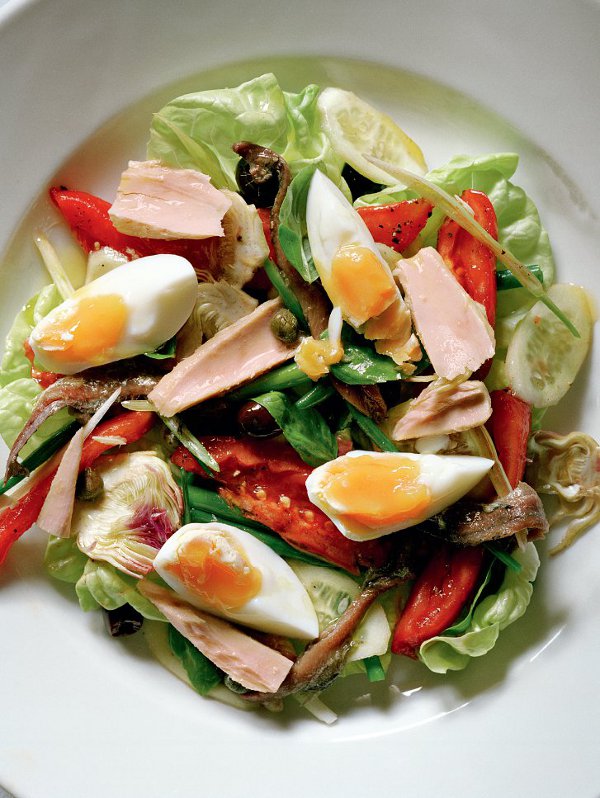
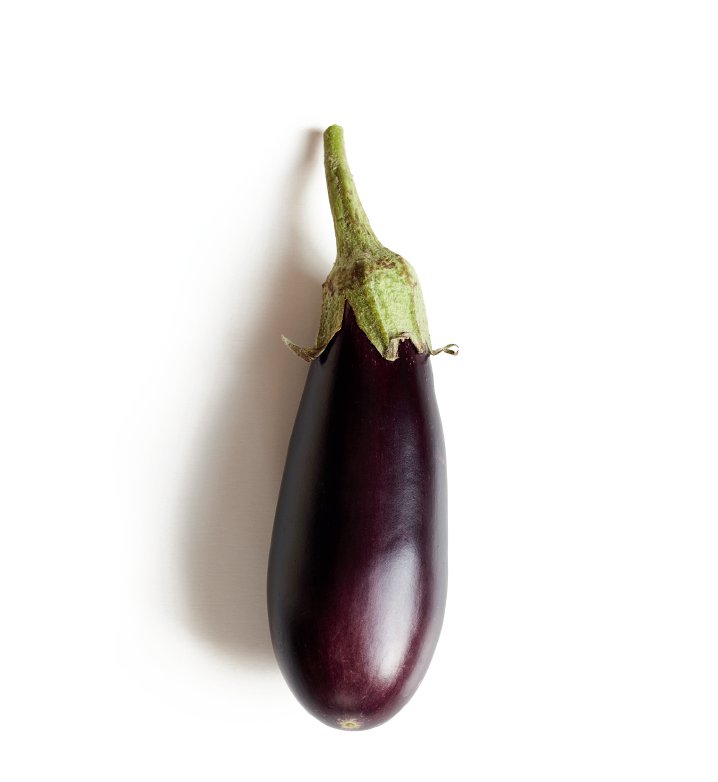
aubergine
